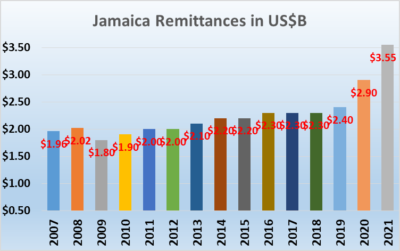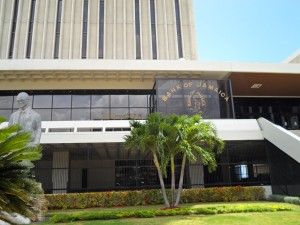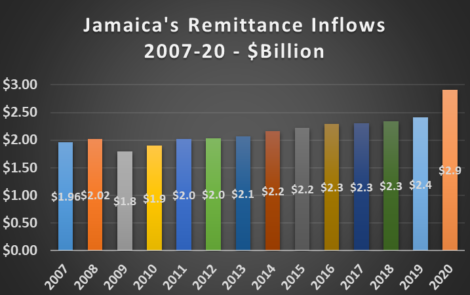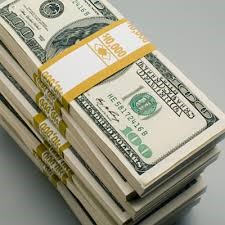Remittances inflows to Jamaica surged to US$3.18 billion for the first 11 months of 2021 after pulling in US$274.5 million in November, an increase of 15.6 percent or US$37 million over the comparative period in 2020, data out of the Bank of Jamaica shows.
 The performance for November puts the total intake for 2021 above the US$2.9 billion hauled in for January to December 2020. The outturn for 2021 seems set to exceed $3.5 billion for the year when the final numbers are tallied for December.
The performance for November puts the total intake for 2021 above the US$2.9 billion hauled in for January to December 2020. The outturn for 2021 seems set to exceed $3.5 billion for the year when the final numbers are tallied for December.
Based on the performance to date and the consistency of the monthly increase the 2021 inflows seem set to exceed by $1.1 billion the inflows of US$2.406 billion the country received in 2019 and just over $600 million more than the total for over 2020.
Data show Jamaica receiving around $2 billion more inflows in the last two years over and above the trend up to 2019. Between 2007 and 2019 inflows grew around US$1 00 million per annum, with no growth in inflows in 2015, 2017 and 2018. The increase in 2020 and 2021 broke the trend of low growth experienced since 2007.
Persons within the financial sector attribute the increased flows to a number of factors including many Jamaica who lives abroad buying real estate and contributing to the building boom in Jamaica others are of the view that the transfer of funds by the government’s fiscal stimulus to individuals, primarily in the United States is also a big contributor.
Remittances on track to exceed US$3.5B
Jamaica’s NIR jumps $104m in December
One signal of the health of a country’s international trade can be viewed from the performance of its net international reserves, based on this, the Jamaican economy could be in a pretty decent shape.
 Jamaica has seen a bounce in remittances in the country climbing from just $2.4 billion in 2019 to $2.9 billion in 2020 and is expected to touch US$3.6 billion last year. In addition, tourism inflows have bounced back well in 2021, with preliminary data indicating that in December last year arrivals could be down 24 percent against that of 2019 before the disruptions in 2020 started, with all of 2021 down 45 percent on 2019. Bank of Jamaica reported that the country’s net international reserves rose US$104 million in December over November 2021 to close the year at $$4 billion and is up from US$3.1 billion at the end of 2020.
Jamaica has seen a bounce in remittances in the country climbing from just $2.4 billion in 2019 to $2.9 billion in 2020 and is expected to touch US$3.6 billion last year. In addition, tourism inflows have bounced back well in 2021, with preliminary data indicating that in December last year arrivals could be down 24 percent against that of 2019 before the disruptions in 2020 started, with all of 2021 down 45 percent on 2019. Bank of Jamaica reported that the country’s net international reserves rose US$104 million in December over November 2021 to close the year at $$4 billion and is up from US$3.1 billion at the end of 2020.
Jamaica’s remittances up again in October
 Total remittance inflows climbed a respectable 8.8 percent for an increase of US$24 million to US$296 million, up from US$272 million in 2020.
Total remittance inflows climbed a respectable 8.8 percent for an increase of US$24 million to US$296 million, up from US$272 million in 2020.
The increase continues the robust growth remittance inflows enjoyed since May last year. It puts the total inflows for the year to date at US44 million short of the total intake for 2020, when US$2.905 billion was taken in for the year to the end of December. At the pace inflows have grown, the take for the current year could hit a record US$3.5 billion, data released by the Bank of Jamaica is suggesting.
Remittances slow from torrid pace
 Jamaica’s remittances inflows slowed from the torrid pace experienced between May, last year to May this year, with an increase in June and July of 10 percent each over the record levels of 2020 with increases of 42 percent and 37 percent respectively in 2020 over 2019 and bringing the year to date growth to 30.4 percent, down from 42 percent to May this year.
Jamaica’s remittances inflows slowed from the torrid pace experienced between May, last year to May this year, with an increase in June and July of 10 percent each over the record levels of 2020 with increases of 42 percent and 37 percent respectively in 2020 over 2019 and bringing the year to date growth to 30.4 percent, down from 42 percent to May this year.
According to a release from Jamaica’s Central Bank, June enjoyed inflows of US$303 million versus US$275 million last year and July US$324 million, up from US$293 million in 2020. For the year to July, the country has garnered US$2 billion up from US$1.56 billion for the same period in 2020. Remittances appear on track to hit US$3.5 billion by the end of the year if the recent trend continues which would be US$600 million than last year and US$1.1 billion over 2019.
Remittance boom continues for Jamaica
Jamaica continues to benefit from a big surge in remittance inflows that started in May last year and is continuing with a big 28.7 percent jump to US$309 million in May this year, from $240 million in May last year.
 This year’s performance is important as it was in May 2020 that the big upsurge in inflows commenced, with May 2020 inflows rising by 15.7 percent over 2019 inflows, bettering the decline recorded in March and April last year to the same months in 2019. For the year to date, total remittance inflows are up an incredible 42 percent over 2020 to reach US$1.4 billion for the five months period from US$987 million in 2020.
This year’s performance is important as it was in May 2020 that the big upsurge in inflows commenced, with May 2020 inflows rising by 15.7 percent over 2019 inflows, bettering the decline recorded in March and April last year to the same months in 2019. For the year to date, total remittance inflows are up an incredible 42 percent over 2020 to reach US$1.4 billion for the five months period from US$987 million in 2020.
With the final seven months of 2020 generating inflows of $1.9 billion, total inflows for the current year should exceed US$3.4 billion and is likely to move closer to $3.9 billion based on the outturn for June this year over 2020.
Persons and businesses interested in foreign exchange developments for Jamaica should pay keen interest in what is happening in this market segment. If the remittances this year hold in 2022, with the rebound in stopover visitor arrivals set to return to normal levels in that year as well, would Jamaica be in a comfortable position for the central bank to build up reserves handily and it could also lead to some revaluation to the local currency.
Remittances surged 65%
Remittances into Jamaica surged a massive 65 percent in March, this year over the inflows for the same month in 2020 and probably the strongest monthly rise on record. Inflows saw US$328 million flowing into the financial system compared to just US$199 in 2020.

Jamaica’s Central Bank
The highest growth in 202 was June with an increase of 42 percent and inflows of US$275 million, while December with US$301 million was the only month that saw inflows reaching the US$300 million mark after it increased 35 percent over the prior year’s period.
For the year to date, inflows are up 42 percent over 2020, with increases of 33 percent in January and 27 percent for February. The development for the first quarter indicates that the country is on target to exceed US$3 billion in one year, for the first time, in 2021, with 2020 reaching a record US$2.9 billion. The trend suggests that 2021 is on track to reach or exceed US$3.4 billion.
Jamaica’s reserves spike US$100m
Jamaica’s Net International Reserves climbed US$100 million higher in May to reach US$3.42 billion from US$3.32 at the end of April after a $300 million surge in March with a rise of US$303 to US$3.32 billion from US$3.016 billion at the end of February, this year.
 The country’s gross reserves are now at US$4.35 billion and include US$930 million due to the International Monetary Fund. The increase in May comes at a time when inflows from tourism are at the highest levels since March 2020 as the sector makes rapid strides in recovery, with May having the highest number of overseas visitors since the country reopened its borders to tourist in June last year. Reports from the tourism industry suggest that visitor arrival numbers for June and July will be appreciably better than for May and should add to foreign currency inflows into the country and most likely the NIR as well.
The country’s gross reserves are now at US$4.35 billion and include US$930 million due to the International Monetary Fund. The increase in May comes at a time when inflows from tourism are at the highest levels since March 2020 as the sector makes rapid strides in recovery, with May having the highest number of overseas visitors since the country reopened its borders to tourist in June last year. Reports from the tourism industry suggest that visitor arrival numbers for June and July will be appreciably better than for May and should add to foreign currency inflows into the country and most likely the NIR as well.
The country is also benefitting from a continued increase in remittances inflows that became evident since May 2020.
The reserves are at the highest sustained levels in the country’s history. The net reserves represent an estimated 30.57 weeks of Goods & Services imports for Jamaica.
Remittances to exceed US$3B for the first time
Remittance inflows for January and February this year to Jamaica grew by 29.8 percent from US$367 million to US$477 million, and now seems set to push total inflows to more than US$3 billion for the year and the first time ever that this landmark would have been reached, having hit US$2.9 billion in 2020.
 Total remittance inflows for February rose 27 percent to US$236 million from US$186 million in 2020.
Total remittance inflows for February rose 27 percent to US$236 million from US$186 million in 2020.
The gains this year come in contrast with the similar period last year US$3 billion hat grew by 9 percent over 2019, well off the 30.85 percent average monthly increase between May and December last year.
In 2020, April numbers fell nearly 10 percent versus inflows for April 2019 and could jump sharply in 2021, thereafter the big surge in inflows will probably return to more moderate growth levels in keeping with recent growth rates that have been lower than 10 percent.








